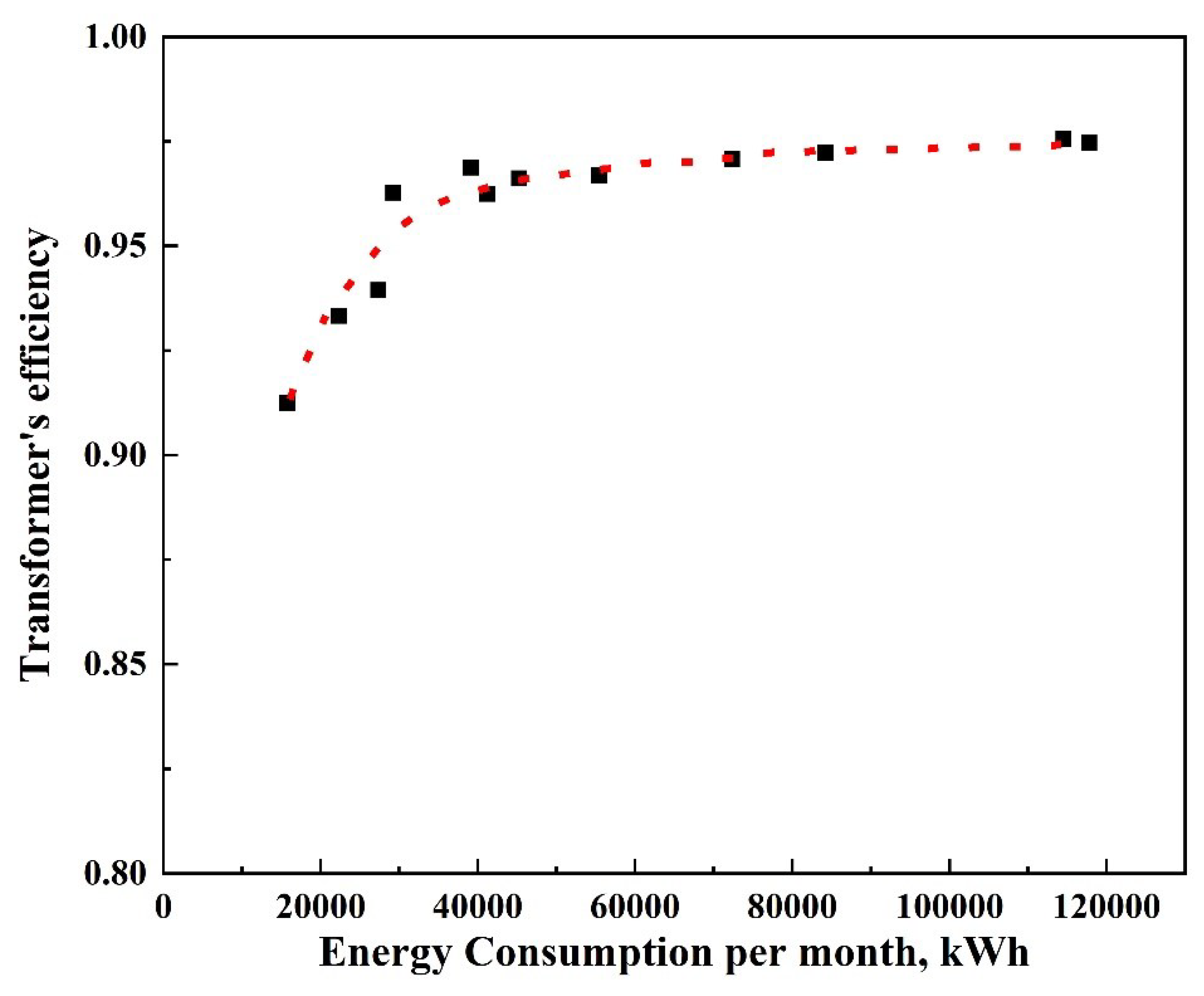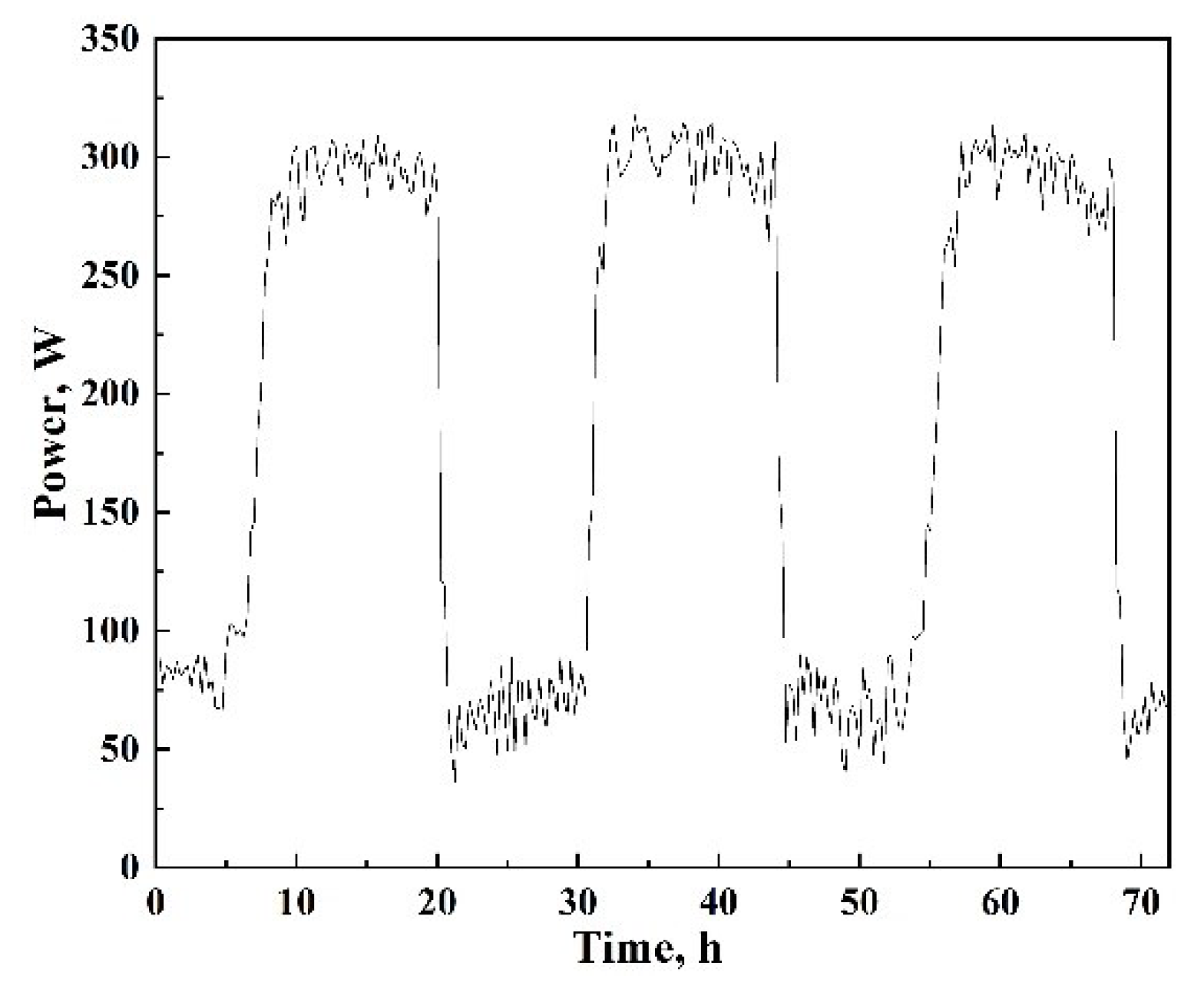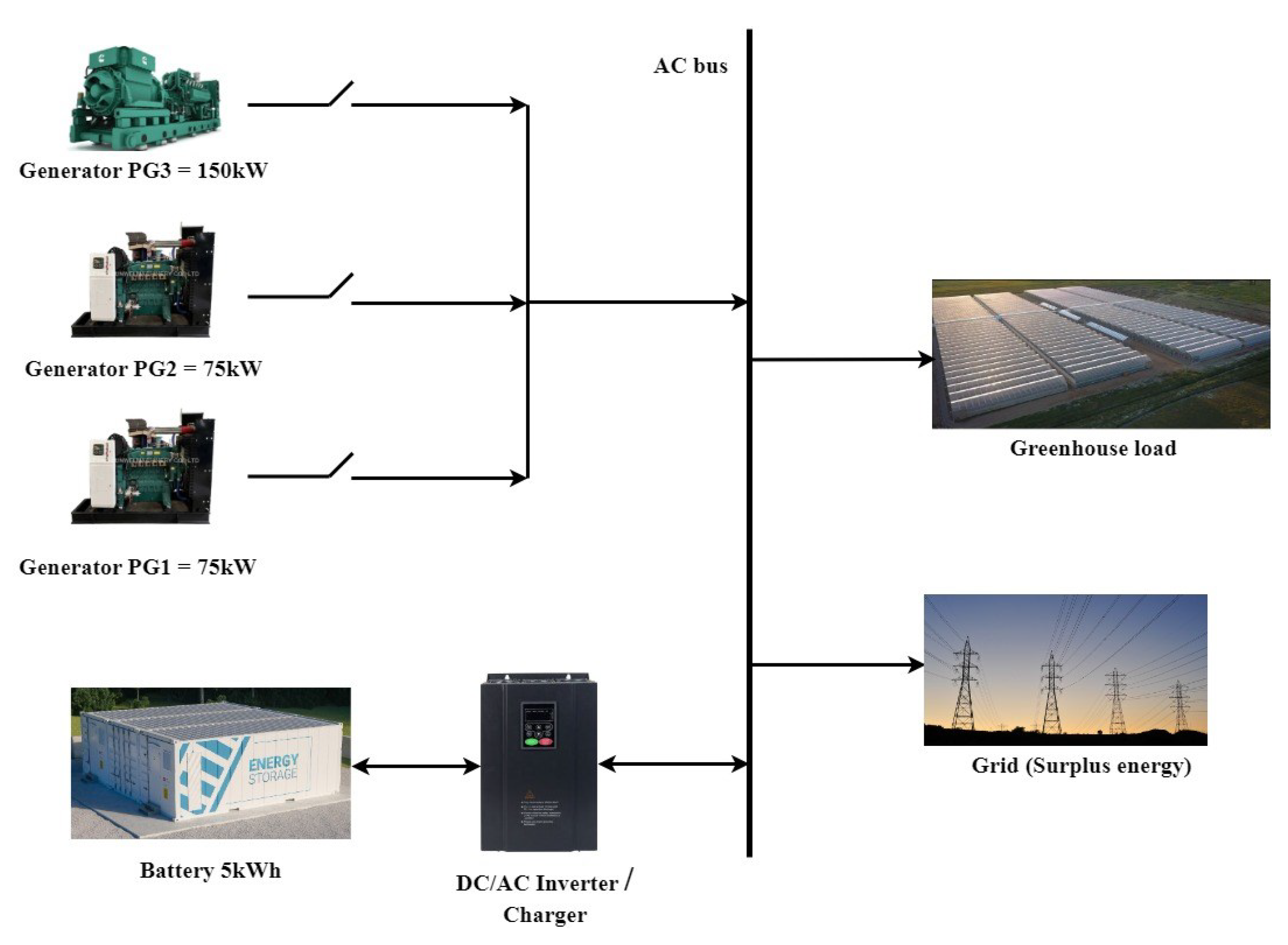Submitted:
07 February 2024
Posted:
07 February 2024
You are already at the latest version
Abstract
Keywords:
1. Introduction
2. Materials and Methods
2.1. Experimental Setup for Power Measurements
3. Results and Discussion
3.1. Analysis of Load Profile
3.2. Operation algorithm
Conclusion
Author Contributions
Funding
Institutional Review Board Statement
Informed Consent Statement
Data Availability Statement
Acknowledgments
Conflicts of Interest
References
- Gorjian, S., Calise, F., Kant, K., Ahamed, M. S., Copertaro, B., Najafi, G., Zhang, X., Aghaei, M., & Shamshiri, R. R. (2021). A review on opportunities for implementation of solar energy technologies in agricultural greenhouses. Journal of Cleaner Production, 285. [CrossRef]
- Santamouris, M., Balaras, C. A., Dascalaki, E., & Vallindras, M. (1994). Passive solar agricultural greenhouses: A worldwide classification and evaluation of technologies and systems used for heating purposes. Solar Energy, 53(5), 411–426. [CrossRef]
- Zhang, K., Yu, J., & Ren, Y. (2022). Research on the size optimization of photovoltaic panels and integrated application with Chinese solar greenhouses. Renewable Energy, 182, 536–551. [CrossRef]
- Zhang, K., Yu, J., & Ren, Y. (2022). Demand side management of energy consumption in a photovoltaic integrated greenhouse. International Journal of Electrical Power and Energy Systems, 134, 107433. [CrossRef]
- Li, C., Wang, H., Miao, H., & Ye, B. (2017). The economic and social performance of integrated photovoltaic and agricultural greenhouses systems: Case study in China. Applied Energy, 190, 204–212. [CrossRef]
- Nayak, S., & Tiwari, A. (2007). Performance evaluation of an integrated hybrid photovoltaic thermal (PV/T) greenhouse system. In International Journal of Agricultural Research (Vol. 2, Issue 3, pp. 211–226). [CrossRef]
- Boughanmi, H., Lazaar, M., & Guizani, A. (2018). A performance of a heat pump system connected a new conic helicoidal geothermal heat exchanger for a greenhouse heating in the north of Tunisia. Solar Energy, 171(June), 343–353. [CrossRef]
- Zhang, M., Yan, T., Wang, W., Jia, X., Wang, J., & Klemeš, J. J. (2022). Energy-saving design and control strategy towards modern sustainable greenhouse: A review. Renewable and Sustainable Energy Reviews, 164(April). [CrossRef]
- Gorjian, S., Ebadi, H., Najafi, G., Singh Chandel, S., & Yildizhan, H. (2021). Recent advances in net-zero energy greenhouses and adapted thermal energy storage systems. Sustainable Energy Technologies and Assessments, 43(November 2020), 100940. [CrossRef]
- Duque-Acevedo, M., Belmonte-Ureña, L. J., Plaza-Úbeda, J. A., & Camacho-Ferre, F. (2020). The management of agricultural waste biomass in the framework of circular economy and bioeconomy: An opportunity for greenhouse agriculture in Southeast Spain. Agronomy, 10(4). [CrossRef]
- Thrace Greenhouses, Available online: https://www.thracegreenhouses.com/gr/en/home/ (accessed on 5/2/2024).
- Sustainability report, Available online: https://www.thracegreenhouses.com/gr/en/aeiforos-anaptiksi/#ekthesi-viosimis-anaptiksis (accessed on 5/2/2024).
- Gioulounta, Κ.; Kosmadakis, Ι.; Elmasides, C.; Diamantis, V.; Piskilopoulos, A.; Amiridis, I.; Stamatelatou, K. Energy valorisation of the residual biomass from greenhouses in the framework of a circular economy. In Proceedings of the Earth and Environmental Science Conference, Athens, Greece, 22-23 October 2022. [CrossRef]
- Gioulounta, K., Matska, M., Piskilopoulos, A., & Stamatelatou, K. (2023). Greenhouse Residues’ Potential for Biogas Production. Applied Sciences (Switzerland), 2023; 13: 5445. [CrossRef]
- Bortolini, M., Gamberi, M., Graziani, A., & Pilati, F. Economic and environmental bi-objective design of an off-grid photovoltaic-battery-diesel generator hybrid energy system. Energy Conversion and Management, 2015; 106: 1024. [CrossRef]
- Dhundhara, S., Verma, Y. P., & Williams, A. Techno-economic analysis of the lithium-ion and lead-acid battery in microgrid systems. Energy Conversion and Management, 2018; 177: 122. [CrossRef]
- Ahmed, M. M., Das, B. K., Das, P., Hossain, M. S., & Kibria, M. G. Energy management and sizing of a stand-alone hybrid renewable energy system for community electricity, fresh water, and cooking gas demands of a remote island. Energy Conversion and Management, 2024; 299: 117865. [CrossRef]
- Mohammed, C., Mohamed, M., Mohamed Larbi, E., Manale, B., Hassan, Z., Jalal, B., & Smail, Z. Extended method for the sizing, energy management, and techno-economic optimization of autonomous solar Photovoltaic/Battery systems: Experimental validation and analysis. Energy Conversion and Management, 2022; 270:116267. [CrossRef]
- Premadasa, P. N. D., Silva, C. M. M. R. S., & Chandima, D. P. (2021). An optimal configuration of diesel generator and battery storage system for off-grid residential applications. 2021 IEEE Electrical Power and Energy Conference, EPEC 2021, 486–491. [CrossRef]
- Hsu, D., & Kang, L. (2014). Dispatch analysis of off-grid diesel generator-battery power systems. International Journal of Emerging Electric Power Systems, 2014; 15: 161. [CrossRef]
- Arun, P., Banerjee, R., & Bandyopadhyay, S. (2008). Optimum sizing of battery-integrated diesel generator for remote electrification through design-space approach. Energy, 2008; 33: 1155. [CrossRef]
- Kiray, V., Orhan, M., & Chijioke, J. N. (2021). Significant increase in fuel efficiency of diesel generators with lithium-ion batteries documented by economic analysis. Energies, 2021; 14(21). [CrossRef]
- Stamatellos, G., & Stamatelos, T. (2023). Study of an nZEB Office Building with Storage in Electric Vehicle Batteries and Dispatch of a Natural Gas-Fuelled Generator. Energies, 16(7). [CrossRef]
- Gracia, L., Casero, P., Bourasseau, C., & Chabert, A. (2018, November 13). Use of Hydrogen in Off-Grid Locations, a Techno-Economic Assessment. Energies, 11(11), 3141. [CrossRef]
- Schimpe, M., Naumann, M., Truong, N., Hesse, H. C., Santhanagopalan, S., Saxon, A., & Jossen, A. Energy efficiency evaluation of a stationary lithium-ion battery container storage system via electro-thermal modeling and detailed component analysis. Applied Energy, 2018;210,211. [CrossRef]
- Approximate Natural Gas Consumption Chart https://www.generatorsource.com/Natural_Gas_Fuel_Consumption.aspx (accessed on 5/2/2024).
- Regulatory Authority for Energy, Waste and Water (RAEWW), Available online: https://www.rae.gr/genika-nea/76548/ (accessed on 5/2/2024).
- de Vries, H., Nguyen, T. T., & Op Het Veld, B. Increasing the cycle life of lithium ion cells by partial state of charge cycling. Microelectronics Reliability, 2015;55, 2247. [CrossRef]
- Chen, E. (2021). The effectiveness of charge limiting and partial charge limiting. 2021 IEEE Transportation Electrification Conference and Expo, ITEC 2021, 401–406. [CrossRef]
- Saxena, S., Hendricks, C., & Pecht, M. Cycle life testing and modeling of graphite/LiCoO2 cells under different state of charge ranges. Journal of Power Sources. 2016;327,394. [CrossRef]
- Arshad, F., Lin, J., Manurkar, N., Fan, E., Ahmad, A., Tariq, M. un N., Wu, F., Chen, R., & Li, L. Life Cycle Assessment of Lithium-ion Batteries: A Critical Review. In Resources, Conservation and Recycling. 2022;180,106164. [CrossRef]











| Month | Energy before transformer, EBT (kWh) | Energy after transformer, EAT (kWh) |
|---|---|---|
| March-22 | 45268 | 43735 |
| April-22 | 41234 | 39689 |
| May-22 | 72321 | 70204 |
| June-22 | 117751 | 114766 |
| July-22 | 114516 | 111732 |
| August-22 | 84246 | 81912 |
| Septemper-22 | 55447 | 53614 |
| October-22 | 27340 | 25684 |
| November-22 | 22285 | 20798 |
| December-22 | 15814 | 14431 |
| January-23 | 29259 | 28170 |
| February-23 | 39168 | 37946 |
| Variable | Description |
|---|---|
| PG1 | Operating power of the MG in Region 1, 0 - 125kW |
| PG2 | Operating power of the MGs in Region 2, 125 - 200kW |
| PG3 | Operating power of the MGs in Region 3, 200 - 350kW |
| Ebat,N | Rated energy of ESS, kWh |
| PG1 (kW) | PG2 (kW) | PG3 (kW) | |
|---|---|---|---|
| January | 45 | - | - |
| February | 54 | - | - |
| March | 56 | - | - |
| April | 57 | - | - |
| May | 55 | 130 | 280 |
| June | 55 | 134 | 280 |
| July | 75 | 134 | 295 |
| August | 60.14 | 149.7 | 209.7 |
| September | 57.95 | 150 | 210 |
| October | 28.92 | 150 | 210 |
| November | 32.5 | - | - |
| December | 18 | - | - |
| MAX Power | 75 | 150 | 295 |
| Generator size (kW) | ¼ Load (m3/h) | ½ Load (m3/h) | ¾ Load (m3/h) | Full Load (m3/h) |
| 75 | 11.3 | 16.7 | 22.7 | 28.0 |
| 150 | 20.7 | 32.1 | 44.2 | 55.1 |
| Month | Fuel Consumption of PG1 (m3) | Fuel Consumption of PG2 (m3) | Fuel Consumption of PG3 (m3) | Total Fuel Consumption (m3/month) |
|---|---|---|---|---|
| January | 14229 | - | - | 14229 |
| February | 14616 | - | - | 14616 |
| March | 16335 | - | - | 16335 |
| April | 16201 | - | - | 16201 |
| May | 10724 | 8076 | 9179 | 27980 |
| June | 7433 | 3601 | 30755 | 41789 |
| July | 10692 | 3459 | 29508 | 43659 |
| August | 10927 | 6850 | 12486 | 30263 |
| September | 13816 | 2432 | 5947 | 22195 |
| October | 10528 | 155 | 489 | 11172 |
| November | 11057 | - | - | 11057 |
| December | 8185 | 8185 | ||
| Total Fuel Consumption (m3/year) | 257681 | |||
Disclaimer/Publisher’s Note: The statements, opinions and data contained in all publications are solely those of the individual author(s) and contributor(s) and not of MDPI and/or the editor(s). MDPI and/or the editor(s) disclaim responsibility for any injury to people or property resulting from any ideas, methods, instructions or products referred to in the content. |
© 2024 by the authors. Licensee MDPI, Basel, Switzerland. This article is an open access article distributed under the terms and conditions of the Creative Commons Attribution (CC BY) license (http://creativecommons.org/licenses/by/4.0/).





